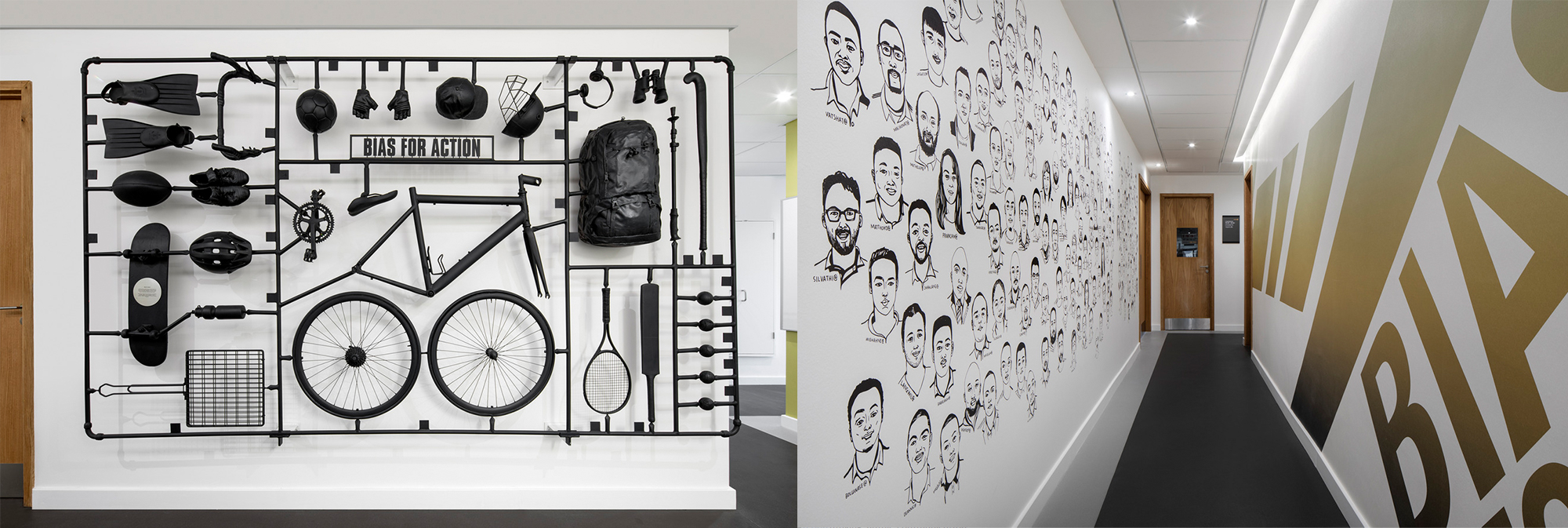By Rob Atkinson | Senior Project Manager
&
Diane Rogers | Senior Strategist
Introduction: Human Evolution and Music
Humans have evolved to perceive the world through five senses. Despite huge technological advancements, we remain hard-wired, dependant on those same senses that we relied on to adapt and survive in the natural world. Our ability to control our surroundings has advanced exponentially, yet challenges remain to ensure the built environment delivers comfort, interest, and inspiration to user senses. Sound and hearing are a big part of that challenge.
For every pleasant audio experience there are a thousand examples of the chaos of noise—the beeps, alarms, sounds of construction and traffic that unsettle our nervous system and contribute to the stress of modern life. These disruptive sharp sounds unnerve us precisely because the body’s survival mechanisms have evolved to recognize them as a source of potential danger, triggering the release of cortisol to prime us for a fight-or-flight scenario. Many such noises are heard in the workplace as a myriad of notifications and alerts, along with moments of deafening silence. As workplace designers and architects it is critical that we strive to replace them with instances of comfort and engagement.

There are many ways in which music can impact an organization's culture. Rapid7, Boston. Photography © Robert Benson.
Music in the Workplace
While the outside world may be chaotic, humans tend to spend about 90% of their time indoors. Whether working at the office or from home, the organization and design of these interior environments potentially impact our wellbeing, affecting our productivity, creativity, and overall wellness. The challenge is to create holistic spaces for occupants that are designed around all the senses, as well as intangibles such as comfort and light and sound.
Music Divides Opinion but can Motivate and Inspire
Intangibles are those more subtle elements that contribute to the character of an interior environment. Sound as one of those elements interacts with our bodily systems. When controlled correctly it can affect us and create curated neurological experiences, helping to manage anxiety and stress, increase alertness, and even encourage community among those working in the same environment. Music can set the tone of a space as witnessed at spas, restaurants, and an array of social gatherings and venues. For that matter you can even ask Alexa for music to suit your mood or to play something for meditation, relaxation, or a rainy day. From a business standpoint, it can contribute to a client’s first impression when entering an organization’s space.
The Neurological Impact of Music on Productivity
Many studies illustrate the benefits of music on mood or creativity, but relatively few correlate music to productivity. Those studies that do tend to come to the same conclusion: music affects listener productivcity in very different ways depending on the individual and the music. The jury is still out on whether music has a positive impact on overall productivity, concentration, and memory. Rickard, Toukhsati & Field (2005), Chou & Ming (2010), & Shih, Huang, & Chiang (2009) would argue that most music correlates to a negative performance on tests for memory or concentration, while Mori, Naghsh, & Tezuka (2014), Wu & Shih (2019), Taruffi, Pehrs, Skouras, Koelsch (2017), and others suggest that music is generally beneficial to productivity.
That said, there are neurological effects that most researchers can agree on. For example, music can boost creativity, and in some cases, there have been additional benefits depending on the music selection and whether those being studied have a musical background. Certain types of music reliably result in a release of specific hormones, such as dopamine, and can aid some to focus or even fall asleep. These hormone releases mean that music has definite utility in mood regulation, even in response to specific scenarios such as the Covid-19 lockdown.
Music impacts every part of the brain; its application can improve motor skills, symptoms of anxiety and depression, stress, and more. Although decades of data have proved specific types of music can have varying neurological impacts, many studies have engaged relatively small sample sizes, often only representing Western music, audiences, or settings. There is much more research to be done.

An open office setting at Cognizant's Phoenix office.
Putting Music to Work in the Office
Music is already a significant factor within workplace environments. According to research conducted by Dr Anneli Haake on behalf of Totaljobs (pre-pandemic), workers in the UK listened to music for 36% of their work week. The research demonstrated its benefits, which were helping to improve mood, preventing distractions from work, and creating a sense of community when the office environment was too quiet. It concluded that 79% of people would benefit from listening to music at work. However, over one-third (38%) of workers were either not enabled or allowed to listen to music due to company policy.
Sound can nurture culture in a way that both clients and employees perceive and respond to. Brands actively manage how they are seen by using sound to engage with their clients’ moods via advertisements and social media. Surely, just as much effort should go into designing the audio experience of a brand’s physical environments.
Do All Spaces Require Music?
Where there is a need for Silence
While many spaces could benefit from curated music experiences, there are often scenarios that require concentration or privacy. In this context, much like being in a library, the lack of sound makes any workplace noise (particularly conversation) that much louder.
Sound masking (the process of adding background sound to reduce noise distractions) has been highly effective in addressing this issue. Masking involves the distribution of ambient sound, similar to the sound of airflow, through speakers either above or below ceiling levels that is engineered to mimic the frequency of human speech. It reduces the radius in which sound can be heard, making an environment less distracting, protecting speech privacy, and increasing office comfort, which is particularly useful for open-plan environments where there is liable to be lots of distracting noises and conversations.
If the objective is to use sound strategically, one idea may be to limit curated sound and music experiences to smaller areas like reception, social, and wellness spaces, etc., where any distraction is limited to an enclosed environment, while using sound masking for larger, open office environments.
Music or Sound?
With the relationship between music and productivity unclear, other forms of sound offer interesting alternatives and applications in the workplace. Binaural beats (music where two tones of comparable but different frequency are played in separate ears), for example, have shown promising applications when it comes to focus and relaxation. In recent work with a confidential tech client in Silicon Valley, IA was tasked to create meditation rooms that explore the relationship between color and music (binaural beats). According to research, the combination of colored lights and soothing sounds should help to establish zones where employees can relax and recuperate from mental fatigue, stress, and physical exhaustion.
Outside of traditional music, there have been several interesting studies highlighting the benefits of natural sounds. Bird song, for instance, can inspire feelings of reassurance. A 2021 study conducted at national parks found that water sounds had the “largest effect on health and positive affective outcomes” of any natural sounds. Several IA clients have had positive experiences with curated natural sounds in wellness and meditation spaces and other areas.

A meditation space at the Palo Alto offices of a confidential IA tech client.
Where to Start
So, what is the best type of music (or other sound) to play in an office? Ultimately, the answer is “it depends,” but there are six questions that will help determine the answer that is right for a given space.
What music is consistent with the brand?
First understand the brand, its values, and music style (contemporary, classic, sporty, cutting edge, etc.). Is there any specific affect the music should have on users (e.g., relax or motivate customers) that is consistent with brand guidelines?
What work is being done in the space targeted for sound?
As noted, different types of music can impact people in a variety of ways, emotionally, physiologically, or psychologically. This means that every type of music has the potential to offer an array of effects in a given space. Consider the purpose of the area targeted for music. As an example, is the space used for creative brainstorming? If so, theoretically it could be beneficial to play happy, upbeat music. Or will users want to use the space for heads down work? Binaural beats, instrumental songs, or even silence might be the best for that area with users allowed to select the music they prefer. What about non-working environments that are acoustically enclosed such as mothers’ rooms and wellness rooms? In these areas, playing natural sounds could allow users to decompress when they are emotionally or psychologically under stress.
Does it make sense from an acoustical perspective?
Overlapping or competing sounds can be a major distraction making simple communication extraordinarily difficult. Identifying the acoustic relationship between spaces is a critical part of designing an office, let alone developing its music strategy.
Is there balance?
As a means of encouraging a workplace that supports neurodiversity, creating a balance between natural sound, music, and intentional silence can offer support and refuge for people who are neurodiverse, overwhelmed by workplace stress, or simply looking for more control in their work environment. When creating these safe spaces it is also important to put specific policies into place regarding phones or other devices.

IA helped this confidential tech client to create a playlist that encouraged movement and use of a stairwell.
Can the Use of a Particular Space or a Set of Behaviors be Encouraged?
Sound can invite the use of underutilized spaces like corridors and stairwells, encouraging people to walk, climb steps, and generally exercise more. For example, IA undertook a project where a curated playlist of songs in 4/4 time was played in stairwells, and the client reported an increased use of the stairwells over a nearby elevator. The music’s BPM (beats per minute) was slightly higher than a typical heart rate and encouraged a faster pace for those ascending and descending the stair. Users began to choose the stairs over the elevator, presumably because they overtly or intuitively enjoyed that their heart rate was keeping pace with the music, more oxygen was flowing through their veins, and the music was pleasurable.
While this was done for wellness purposes, similar tactics could be used to encourage optimal space utilization, relaxation, user activity and volume, or to simply create moments of delight.

At Sonos' Boston office, music agency was a highly-valued aspect of the overall design. Photography © Robert Benson.
Is There Control and Agency?
Once it is decided where music will be played, it is important to identify those areas where music will be curated for a specific purpose (generally for branding, such as in reception areas, etc.) versus music controlled via a shared playlist.
Having a centralized, secured point where music is controlled is especially helpful since it prevents individuals from modifying a system to their personal taste. But with the right tools, some agency for employees can also be provided, allowing the use of collaborative playlists as bonding experiences with colleagues. This is especially relevant in spaces designed for interpersonal connection, such as café and gaming areas, where productivity is less critical than relationship. By sharing playlists during specific tasks, staff can break the ice with new employees, boost morale, create conversation, and promote harmony.
Many platforms offer accounts that update playlists remotely. This creates other possibilities, such as playlists designed for specific times of day, for instance when energy and concentration may be flagging. It is important that design and user teams work with acoustic engineers to ensure that designated spaces are acoustically geared to predetermined volume levels and that users in open office spaces can choose their own music at their preferred volumes via personal headsets.

Collaboration in song selection can help bring teams together in the right environments, without causing undue distraction. TIAA, Charlotte. Photography © Keith Isaacs.
Final Thoughts
In subsequent blog posts, we will discuss other factors necessary for designing and implementing an effective music strategy for the workplace, including licensing and legality, volume control, tools for creating agency, and how to make sure the music selection is in sync with branding and EGD efforts. But at this beginning stage, it is critical to concentrate on the relationship between people, purpose, place, and positioning. Everyone is affected by music differently, but there is, without a doubt, an impact and myriad possibilities around how it can positively affect user behavior and mood.


